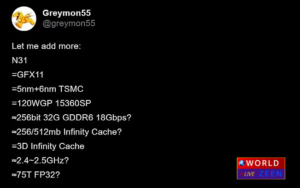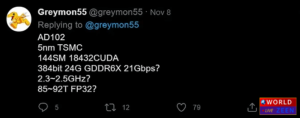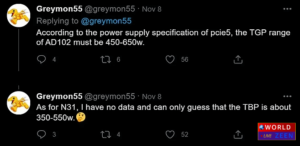Battle Between Two Flagship GPU: Radeon RX 7900 XT vs GeForce RTX 4090
It is quite interesting why leakers tend to share their collected data on Radeon RX 7900 XT and Geforce RTX 4090 on the same day. It is important to note that both leakers clearly have good sources because their leaks have proven to be true so many times.
Like many of the prominent leakers named Greymon55 is popular for sharing fascinating information on technical details and data of upcoming hardware which is in the tiny, and cryptic type of text snippets. At this time around, though, they shared a pile of interesting specifications for NVIDIA’s new AD102 halo-tier Ada Lovelace CPU as well as the new Navi 31 from AMD’s next-generation Radeon, and both of these tweets seem to corroborate and summarize previous rumors and leaks.

We mention it as a package of GPU because of rumors have it, that Navi 31 will be an MCM (multi-chip module) design like AMD’s currently revealed AMD Instinct MI200 datacenter compute accelerator. Greymon55 said that, like AMD’s Zen 3 and Zen 2 processors, Navi 31’s multiple dice will be fabricated on sunder processes. In that case, 6nm of TSMC for the cache die and I/O, when TSMC’s refined process which is 5nm is employed on the dual power-thirsty compute dice. That 3rd die will purportedly carry as much as 512MB capacity of Infinity Cache. That is quadruple the amount on the current flagship of AMD, the Radeon RX 6900 XT.
If the predictions hold correct info and AMD is able to get these heavy multi-CPU number munchers up to 2.4~2.5 GHz, that could mean that such a theoretical the AMD RX 7900 XT will based on Navi 31 could chew via as much as 75 teraflops of single-precision (FP32) floating-point math per second. It makes one teary-eyed to look back on the AMD Radeon HD 7970 graphics card and its meager 4 TFLOPs performance nearly about a decade ago.

NVIDIA is reputedly planning a wider memory interface of 384-bit connecting 24GB capacity of faster GDDR6X type memory at 21 Gbps per pin. If true, that will put the AD102 part at nearly 1TB or 1000GB per sec of memory bandwidth—almost nearly double that of Navi 31. Having a single block of memory that is connected over an ultra-fast bus makes NVIDIA’s chip equivalent serviceable for bandwidth or graphics hungry compute workloads.
By contrast, the RDNA 3 design of AMD is intended for graphics primarily, and that is the motive of the bigger Infinity Cache, which in theory (and in practice on extant AMD RDNA 2 parts) serves for reducing the bandwidth needs of graphics workloads considerably.
The tweeter leaker Greymon55 theorizes a clock rate of 2.3~2.5 GHz for AD102 as well, which will put the chip nearly somewhere in the 85 to 92 TFLOPs range for a single-precision compute. Given NVIDIA’s said status as a one-architecture company, its chips have to be the shady girl who can do both. Luckily, Ada Lovelace indicates more than up to the task.

Those kinds of power requirements are going to make these graphics cards very difficult to cool, and you are not going to be running these graphics cards off your old-school PCI Express power connectors—it will take four cables of eight-pin to run such a graphics card. Instead, it seems probable that both NVIDIA and AMD will be using the currently-confirmed new latest PCI Express 5.0 auxiliary power connector. This connector is equivalent (if not identical) to the one which NVIDIA recently uses on their RTX 3000 series Ampere graphics cards, and that is rated to supply up to 600 watts through a single bundled cable.
Both products are expected to launch late in the next year. NVIDIA’s part is expected in October 2022, and when there is no leaked or rumored timeline for AMD’s parts, the tweeter leaker Greymon55 has insinuated that the red team is aiming for a similar date.
Possibly, before we see any of these parts hit the graphics card market, we will see that long-rumored Nvidia Geforce RTX 3000 Super refresh in advance next year, as well as the entry of Intel into the graphics card market with their first discrete graphics card from the i740 ill-fated. Assuming the shortage of graphics cards lets up. Dr. Lisa Su believes it will—2022 looks to be an exceptionally exciting time period to be a hardware nerd.
Radeon RX 7900 XT price
The expected price of the AMD Radeon RX 7900 XT graphics card is $1,999.
AMD Radeon RX 7900 XT release date
The AMD Radeon RX 7900 XT graphics card will be launched in the first quarter of 2023.
Nvidia Geforce RTX 4090 price
The expected price of the Nvidia Geforce RTX 4090 graphics card is $1,899. That price is less costly compared to the $1,999 of AMD’s Radeon RX 7900 XT graphics card.
Nvidia Geforce RTX 4090 release date
The Nvidia Geforce RTX 4090 graphics card will be launched in October 2022. That is very early compared to the release of AMD Radeon RX 7900 XT graphics card.
In this article, we already discuss the leaked information about the Nvidia Geforce RTX 4090 graphics card and the AMD Radeon RX 7900 XT graphics card. We will publish more articles on the AMD Radeon RX 7900 XT graphics card and the Nvidia Geforce RTX 4090 graphics card after the launch.
If you have any questions about the Nvidia Geforce RTX 4090 graphics card and the AMD Radeon RX 7900 XT graphics card then leave your valuable comments in the comment box below. We will answer your every query as early as possible. If you want to know more updated information on AMD Radeon RX 7900 XT graphics card and the Nvidia Geforce RTX 4090 graphics card then stay tuned with our website.
We will share more updated information with you on the AMD Radeon RX 7900 XT graphics card and the Nvidia Geforce RTX 4090 graphics card in near future.
Sources: Hothardware, AMD 7900 XT, And GeForce RTX 4090 Graphics card Leak,19th April 2022.

